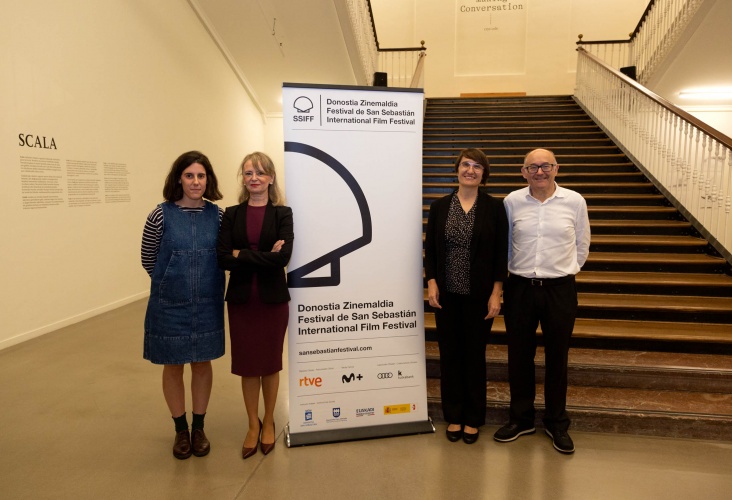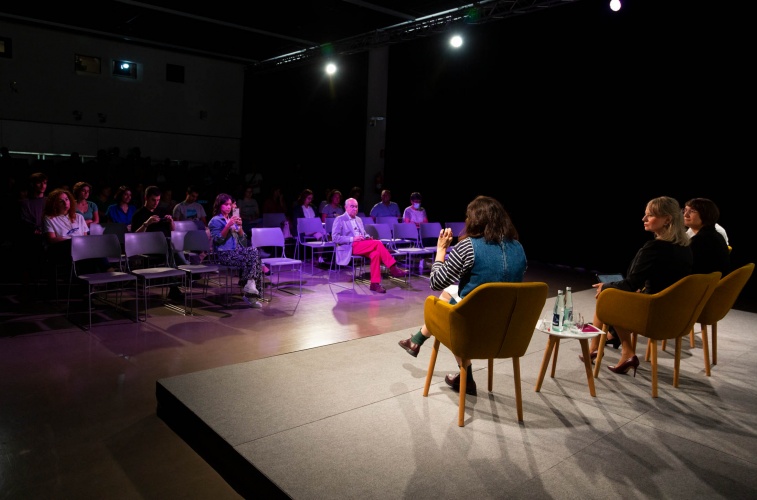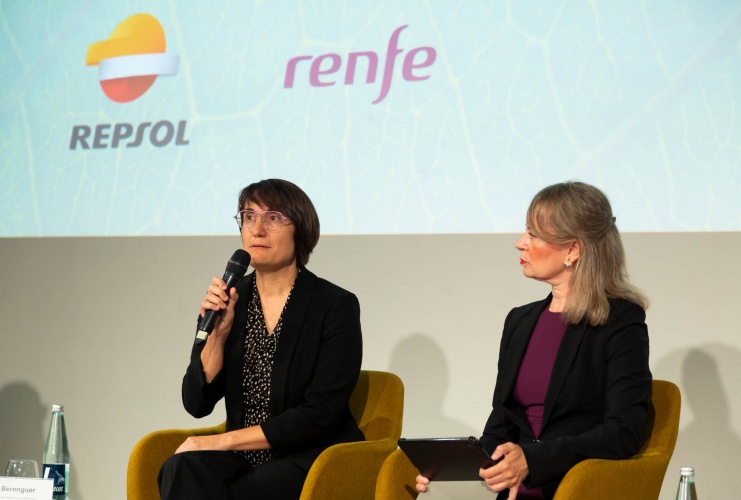For the third consecutive year, the San Sebastian Festival continues to forge ahead with the development of its sustainability plan, employing measures it hopes will make the event carbon neutral in approximately five years. To succeed, the Festival will continue to work on the process of measuring its carbon footprint with the consultancy firm CREAST. In addition, at the 71st edition, Repsol will become a sustainability sponsor, collaborating with its solutions in decarbonising the event, while Renfe will join the initiative as a collaborator. Two travelling companions who will enable the Festival to make a qualitative leap forward with respect to the measures in place for achieving its goal.
This morning, the Z room in Tabakalera hosted the presentation of the measures encompassed by the sustainability plan at the Festival’s 71st edition. Participants in the news conference were the Festival Director, José Luis Rebordinos and its Sustainability Project Coordinator, Amaia Serrulla, together with Siridia Berenguer, Director of Development and New Businesses at Repsol, and Verónica Portell Torres, Director of Communication, Brand and Public Relations at Renfe for the Basque Country, Navarre and Cantabria.
According to the measurement made last year, the Festival’s carbon footprint stands at around 4,147 tonnes of CO2Eq. Although it is impossible to establish the exact percentage of the footprint reduction achieved, as the figures are only estimates, CREAST maintains that measures such as reducing single-use materials, shorter illumination times at an iconic building like the Kursaal, using LED lighting tecnology and almost completely doing away with printing on paper have succeed in considerably reducing the footprint.

Measures at the 71st edition (2023)
The fact that Repsol has joined the Festival as on sustainability as a sponsor will enable us to take a qualitative step forward in reducing emissions at this year’s Festival. The multi-energy company will provide a variety of solutions to make transport sustainable and will supply the event with renewable energy. For the transport, 100% renewable energies have been chosen, with 0 impact on the environment, produced by Repsol from several kinds of waste, such as used cooking oil. Repsol will also make its complete network of public charging points in San Sebastian, with seven stations up and running, available for use by the Festival’s fleet of electric and plug-in hybrid vehicles, and will set up two additional stations on the Paseo de la República Argentina.
Repsol will also provide the Festival with two generators running on 100% renewable fuel and which will cover the energy requirements of the closing gala. Lastly, Repsol will install a portable solar energy generating solution providing renewable electricity to all of the advertising cubes normally installed in the Plaza Okendo during the event and which all visitors can use to charge their mobile phones.
For its part, Renfe will help the San Sebastian Festival to promote more sustainable mobility.
Internally, the Festival will continue working to strengthen the measures set in motion in recent years. Thus, this year sustainability variables have been included in several contract conditions, especially for those related to activities coming with some kind of catering.
The Festival will once again offset its emissions as it did for the first time at last year’s edition, when it paid 25,000 euros into the Gipuzkoa Voluntary Carbon Fund launched by the Naturklima Foundation and the Gipuzkoa Provincial Council’s Department of the Environment. That contribution was invested in projects to improve local green infrastructures and thereby help regenerate the functionality of the natural carbon sinks in Gipuzkoa, mainly its forests and seas.
Report on the 70th edition (2022)
Last year, the Festival’s carbon footprint measurement started in June and ended in December. Having examined the map of suppliers, the Festival hubs and accommodation, the vehicle fleet, sponsors, catering, materials and waste, CREAST established that the Festival’s footprint stood at 4,147 tonnes of CO2Eq. The main sources of emissions are mobility (40%), accommodation (37%) and materials use (19%), followed by catering (2%), electricity consumption (1%) and waste (0.2%).
Among the key points for reducing the carbon footprint caused by mobility, CREAST proposes using more sustainable energies, such as renewable fuels, as well as a progressive increase in the electric or hybrid fleet. In addition, the use of bicycles is recommended for moving around locally, as is coming to the Festival in shared vehicles. With respect to the travel of guests and the journeys made by members of the institution throughout the year, the proposal is also to give priority to more sustainable energies for transport, such as the use of renewable fuels and SAF (Sustainable Aviation Fuel), trains and shared cars whenever possible.
As far as materials are concerned, it is considered essential to continue reducing paper use; last year, for example, the Festival stopped printing its catalogue, so that it is now solely available in its digital version, translating into a reduction in CO2 of 3,584,99 kg, given that each individual catalogue weighed 1.2 kg and that 3,500 units would have been printed. In addition, only 6,000 copies of the Film-by-Film guide were printed, which helped to reduce 653 of CO2eq; for the first time this year, the guide will be printed on 100% recycled paper. It is also necessary to reduce plastic in purchases and packaging, as well as to continue fostering the reuse or purchase of second-hand items rather than buying new ones.
With respect to catering, the recommendation is to encourage a policy that guarantees the purchase of 100% locally-sourced products, to use reusable or biodegradable crockery and cutlery, and to guarantee energy efficiency in the process of making the meals served in the framework of the Festival.
Last year the exterior illumination of the Kursaal was programmed to switch off at 2:15 rather than 4:30, thereby reducing the energy consumed by approximately 46.7%. In addition, the Festival will continue its transition to LED technology for the lighting of its hubs and offices, given that doing so reduces consumption by some 75% compared to traditional lighting (incandescent bulbs and DFL); it will also persevere in its endeavours to reduce the consumption of energy and ensure that it comes from 100% renewable sources.
A working group was also created to manage waste, guaranteeing its separation thanks to the installation of new recycling stations, a measure that the Festival will continue to deploy.
Finally, although water consumption is barely reflected in the carbon footprint indicator due to the fact that its value chain generates almost no emissions, the Festival will continue to promote its efficient use.



























